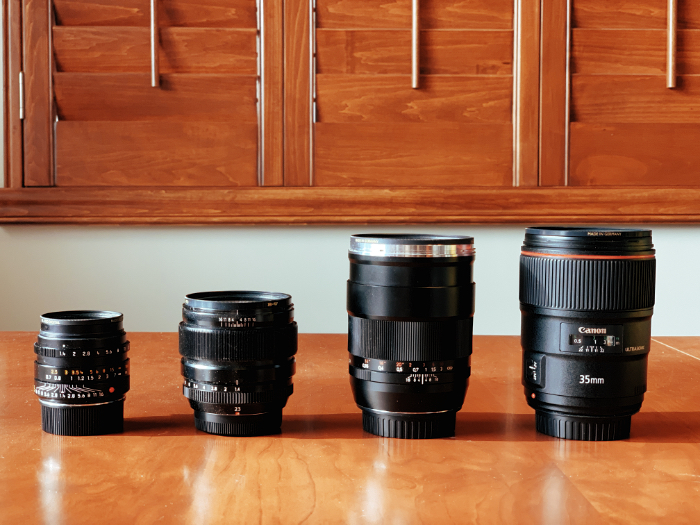From left to right:
Leica 35mm Summilux, f/1.4
Fuji XF 23mm f/1.4 (35mm equivalent)
Zeiss 35mm f/1.4 Distagon EF Mount
Canon EF 35mm f/1.4 II USM
I like big glass, and I cannot lie. But mirrorless cameras were *supposed* to give us smaller camera/lens combinations… and we seem to be going in the wrong direction, at least with respect to size.
Each one of these lenses in the image above is a 35mm f/1.4 lens or a 35mm equivalent and the progression from left to right reflects a modern trend towards bigger and bulkier optical solutions for cameras. And after looking at the new mounts from Nikon Z and Canon RF for their new mirrorless offerings, I’m guessing that the size will continue to increase further at the same time as cell phone cameras are getting better and smaller. Although, I appreciate that increasing lens size is a reality when you are trying to create optimum optical performance, combined with autofocus and image stability mechanisms, and there is no substitute for good optics. This is also why Fuji’s strategy here of sticking with a crop frame sensor (APS-C sized) is a good compromise, and makes sense where Fuji can offer top optical performance with the electronics for autofocus and image stability within a relatively compact package.
Each one of these lenses is a remarkable imaging device that captures my favorite photographic focal length of 35mm full frame equivalent, with a maximum aperture of f/1.4. Two of these lenses are autofocus lenses (the 23mm Fuji and the Canon), and two are manual focus (the Leica and the Zeiss), and every one of these lenses performs in a generally similar manner with some advantages and disadvantages of each. In the Micro-four-thirds arena, the 35mm equivalent would be ~17mm and Olympus makes a spectacular f/1.2 version. But the tradeoff with smaller sensor size is spreading the optical image over a smaller surface which limits the out of focus quality some.
There are lots of ways to engineer a 35mm field of view that create packaging challenges. Externally, the biggest difference between the left and the right is obviously size but in terms of optical performance and use, my preference goes from left to right. Why? A combination of optical performance and the obvious factor, size. To start with, the optical design of the Leica 35mm Summilux is one of the best in the world, eclipsed optically only perhaps by the Zeiss 35mm f/1.4 Distagon made for the Leica M-mount which is to my opinion, truly one of the greatest lenses ever made. The Leica Summilux is a bit smaller than the Zeiss 35mm f/1.4 Distagon M-mount lens, which makes it a little more convenient as a travel lens however.
I’ve written about the Fuji 23mm lens before, and it is my very favorite Fuji lens. The advantage of this lens over the Leica 35mm is clearly the autofocus capability for some. Although lately, I’ve been finding that the images I am more satisfied with are from manual focused lenses which require me to slow down some.
The Zeiss 35mm f/1.4 Distagon made for the EF Mount performs closely to the Zeiss 35mm f/1.4 Distagon for the Leica M-mount, and adapted to a mirrorless camera like the Leica SL makes for a glorious combination that while bulky, just feels perfectly balanced. Optically, this lens has that Zeiss Distagon micro-contrast pop that I love and is the equivalent of the Zeiss Distagon for the Leica mount.
The advantages of Canon EF 35mm f/1.4 II USM are autofocus, the most contemporary lens coatings in this lineup, spectacular image performance, and the ability to map lens properties and perform lens corrections in camera. But I have to have an SLR (or an adapted Canon EOS R) to hang off the back of the lens, and this lens along with the Zeiss make for a bulky package.
There are clearly more ways than one to make lens with a 35mm field of view. And each has a niche, but I know which ones I tend to carry with me more often. I typically carry the smaller lenses with me, especially when traveling where size and weight limitations are becoming increasingly important. For me at least, gone are the days when I want to fly off on an embed or trip with two “pro” bodies and 40 lbs of lenses and batteries. My typical travel camera these days is a Leica M body and a 35mm lens or a Fuji X-Pro2 with the 23mm lens. But if I wanted more flexibility, smaller lenses mean I can carry more options with me in small bags or backpacks, which brings me to the question that drove this post… Mirrorless cameras were *supposed* to give us smaller camera packages. What is happening with the market?
